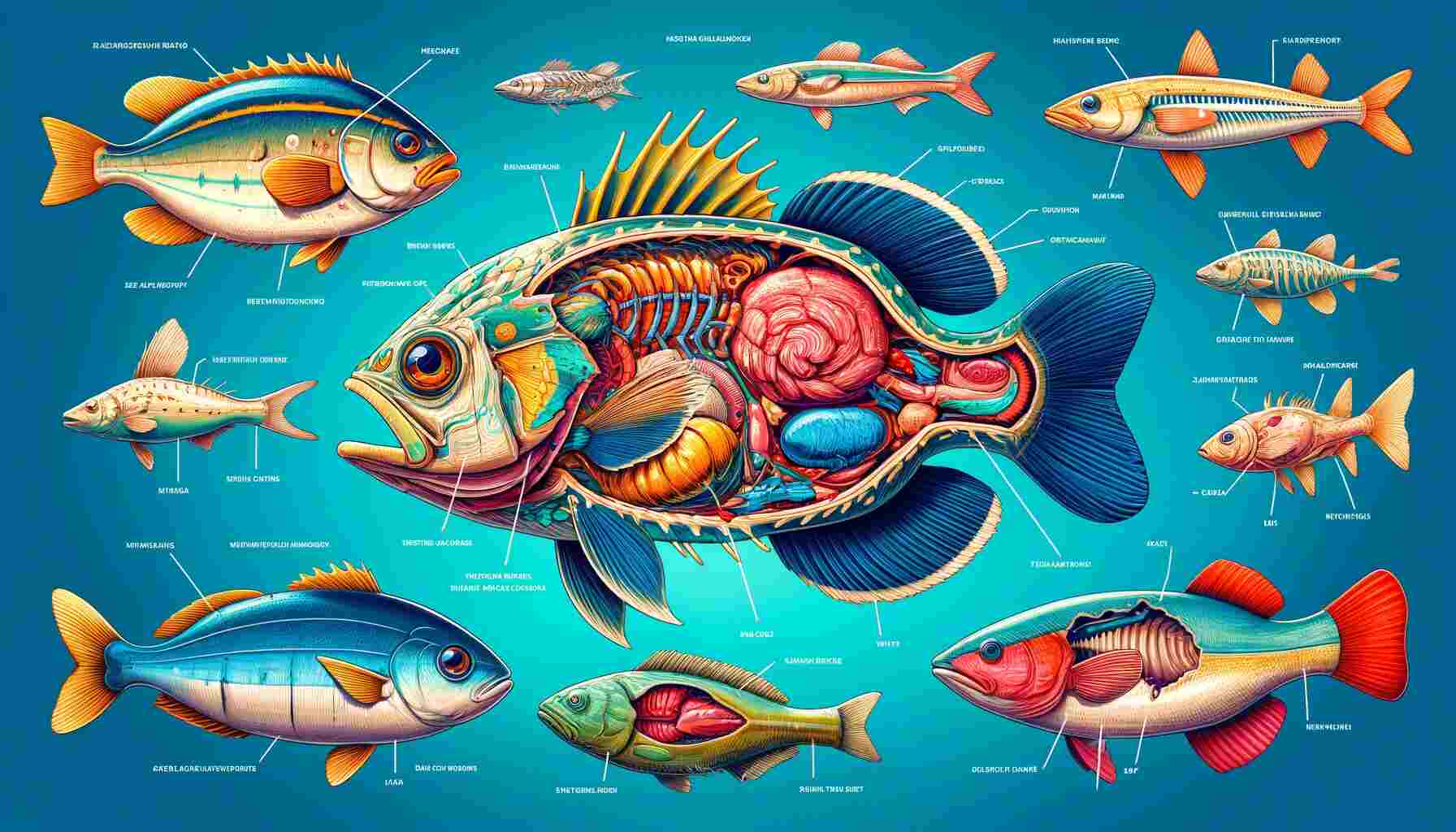Fish are fascinating creatures, forming one of the most diverse and numerous groups of animals on Earth. Understanding fish anatomy is crucial for anglers, marine biologists, and enthusiasts alike. This comprehensive guide will delve into the basics of fish biology, exploring their unique anatomical features and physiological processes.
Table of Contents
1. Introduction to Fish Anatomy
Fish, belonging to the phylum Chordata, exhibit a vast range of anatomical structures. Their bodies are adapted to life in water, showcasing various modifications that enable them to thrive in aquatic environments. The primary anatomical features of fish include their skeletal structure, muscular system, respiratory system, circulatory system, and sensory organs.
2. External Anatomy of Fish
Body Shape and Fins
Body Shape: Fish exhibit a wide variety of body shapes, each suited to their environment and lifestyle. For instance:
- Streamlined Bodies: Typical of fast swimmers like tuna and mackerel, these fish have a torpedo-shaped body that reduces water resistance.
- Flattened Bodies: Seen in bottom-dwellers like flounder and rays, these fish have bodies adapted to lying on the ocean floor.
- Elongated Bodies: Common in eel-like fish, this shape allows for easy navigation through narrow spaces.
Fins: Fins are critical for movement, balance, and steering. The primary types include:
- Dorsal Fins: Located on the back, these fins provide stability.
- Caudal Fin (Tail Fin): This fin is the main propeller for movement.
- Pectoral and Pelvic Fins: These paired fins aid in maneuverability.
- Anal Fin: Located on the ventral side, it helps with stability.
Scales and Skin
Fish are covered in scales, which protect their bodies and reduce friction when swimming. There are four main types of scales:
- Cycloid: Smooth-edged and found in fish like salmon.
- Ctenoid: Rough-edged and seen in perch.
- Ganoid: Diamond-shaped and hard, present in sturgeons.
- Placoid: Tooth-like and found in sharks.
The skin beneath the scales contains mucus-secreting glands, which help in reducing friction, deterring predators, and protecting against infections.
3. Internal Anatomy of Fish
Skeletal System
The skeletal system of fish provides structure and support. It can be divided into two main parts:
- Axial Skeleton: Comprising the skull, vertebral column, and ribs.
- Appendicular Skeleton: Including the pectoral and pelvic girdles and the fins.
Fish skeletons can be either cartilaginous or bony. Cartilaginous fish, such as sharks and rays, have skeletons made of cartilage, which is lighter and more flexible. Bony fish, such as trout and bass, have skeletons made of bone, providing greater support.
Muscular System
Fish muscles are primarily arranged in blocks called myomeres. These muscles are segmented, aiding in efficient swimming movements. There are two main types of muscle fibers:
- Red Muscle: Rich in myoglobin and used for sustained, slower swimming.
- White Muscle: Used for quick, short bursts of speed.
Respiratory System
Fish breathe through gills, which are highly efficient at extracting oxygen from water. The gills are located on either side of the pharynx and are covered by a protective bony plate called the operculum. Water flows over the gill filaments, where oxygen is absorbed and carbon dioxide is expelled.
Circulatory System
Fish have a single-loop circulatory system with a two-chambered heart. Blood is pumped from the heart to the gills, where it gets oxygenated, and then circulated to the rest of the body. This system is efficient for the aquatic environment in which fish live.
Digestive System
Fish have a straightforward digestive system adapted to their diet. The main components include:
- Mouth: Equipped with teeth suited to their feeding habits.
- Esophagus: A short tube leading to the stomach.
- Stomach: Where initial digestion occurs.
- Intestine: Further breaks down food and absorbs nutrients.
- Liver and Pancreas: Produce digestive enzymes and bile.
Excretory System
Fish excrete nitrogenous wastes primarily as ammonia through their gills and kidneys. The kidneys also play a crucial role in osmoregulation, maintaining the balance of salts and water in their bodies.
4. Sensory Organs
Fish have highly developed sensory organs that help them navigate their environment, find food, and avoid predators.
Eyes
Fish eyes are adapted to underwater vision. They lack eyelids but have a spherical lens that allows them to focus in the aquatic environment. Some fish can see ultraviolet and polarized light, which aids in detecting prey and predators.
Lateral Line System
The lateral line is a unique sensory organ found in fish. It consists of a series of fluid-filled canals along the sides of the body that detect vibrations and water currents, helping fish sense their surroundings and communicate with each other.
Ears
Fish have internal ears embedded within the skull. These ears contain otoliths (ear stones) that detect sound vibrations and help maintain balance. Some fish can hear a wide range of frequencies, aiding in communication and predator detection.
Taste and Smell
Fish have well-developed taste and olfactory senses. Taste buds are located in the mouth, lips, and even on barbels (whisker-like structures). The olfactory organs in the nasal sacs are highly sensitive, allowing fish to detect chemicals and pheromones in the water.
5. Reproductive System
Fish exhibit a wide range of reproductive strategies, from external fertilization in most species to internal fertilization in some. The main reproductive organs are:
- Gonads: Ovaries in females and testes in males.
- Spawning: Most fish release eggs and sperm into the water, where fertilization occurs externally.
- Live-bearing: Some fish, like guppies and sharks, give birth to live young.
Courtship and Mating
Fish engage in various courtship behaviors to attract mates. These can include color displays, nest building, and intricate dances. The timing of spawning is often influenced by environmental factors such as temperature, light, and food availability.
6. Unique Adaptations in Fish Anatomy
Bioluminescence
Some deep-sea fish possess bioluminescent organs that produce light through chemical reactions. This adaptation helps them attract prey, communicate, and camouflage in the dark depths of the ocean.
Electric Organs
Certain fish, like electric eels and rays, have specialized electric organs that generate electric fields. These fields are used for navigation, communication, defense, and stunning prey.
Swim Bladder
The swim bladder is an air-filled organ that helps fish maintain buoyancy. By adjusting the amount of gas in the bladder, fish can control their depth without expending much energy.
7. The Importance of Fish Anatomy in Ecology and Conservation
Understanding fish anatomy is crucial for conservation efforts and maintaining healthy aquatic ecosystems. Knowledge of their physiological needs and behaviors aids in habitat protection, fisheries management, and the development of sustainable fishing practices.
Conservation Challenges
Fish populations face numerous threats, including overfishing, habitat destruction, pollution, and climate change. Conservation strategies often involve habitat restoration, protected areas, and regulations on fishing practices to ensure the survival of fish species.
Role in the Ecosystem
Fish play a vital role in aquatic ecosystems as predators, prey, and contributors to nutrient cycling. Their health and abundance impact the entire food web, highlighting the importance of preserving fish biodiversity.
8. Conclusion
Fish anatomy is a fascinating and complex field that reveals the remarkable adaptations of these aquatic creatures. From their streamlined bodies and efficient gills to their specialized sensory organs and reproductive strategies, fish exhibit a wide array of features that enable them to thrive in diverse environments.
Understanding fish biology not only enriches our knowledge but also underscores the importance of conserving these vital members of our planet’s ecosystems.




